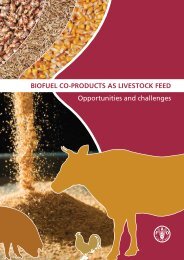Distillers Grains Feeding Recommendations. - Distillers Grains By ...
Distillers Grains Feeding Recommendations. - Distillers Grains By ...
Distillers Grains Feeding Recommendations. - Distillers Grains By ...
You also want an ePaper? Increase the reach of your titles
YUMPU automatically turns print PDFs into web optimized ePapers that Google loves.
3a more desirable array of amino acids and should have supported greater production than theCDG diet. However, this time there was no additional production when the CDG diet wassupplemented with RPLM. Also, production was not significantly higher when fed a blend ofseveral high quality protein supplements instead of CDG as the only protein supplement.The above studies illustrate that CDG is a good quality protein source and that it cannotbe easily improved upon. Corn distillers grains can be easily used as the only source ofsupplemental protein in many dietary situations.Energy in Corn <strong>Distillers</strong> <strong>Grains</strong>Some speculated that the CDG available today might contain more energy than indicatedby the “book” values. Therefore, we (Birkelo et al., 1994) conducted an experiment todetermine the energy value of wet CDG for lactating cows. The research indicated that thedigestible energy (DE), metabolizable energy (ME), and net energy for lactation (NE L ) of wetCDG were 1.86, 1.52, and 1.03 Mcal/lb DM, respectively. These values are 10 to 15% higherthan published in the dairy NRC (2001) for DDGS. This likely reflects a higher energy valuefor newer generation distillers grains and does not necessarily reflect higher energy in wet thanin dried CDG; that would have to be a separate comparison which has not been made.Wet versus Dried <strong>Distillers</strong> <strong>Grains</strong>One of the objectives of this presentation is to provide information about DDGS, but sofar the presentation has contained information almost interchangeably about both wet and drieddistillers grains. That is because the nutrient content of the dry matter is essentially the same forboth wet and dried CDG except for possibly slightly lower RUP values for wet than for driedCDG (Firkins et al., 1984). I am not aware of any trials with lactating cows that directlycompared wet versus dried CDG. The minimal amount of data comparing wet versus driedCDG with beef cattle would indicate that animal performance when fed wet CDG is just asgood as or slightly better than when fed dried CDG. Likewise, I am not aware of directcomparisons between distillers grains versus distillers grains plus solubles. Again, I wouldexpect similar animal performance with both products.The main considerations between the uses of wet versus dried CDG are handling andcosts. Dried products can be stored for extended periods of time, can be shipped greaterdistances more economically and conveniently than wet CDG, and can be easily blended withother dietary ingredients. However, feeding wet CDG avoids the costs of drying the product.There are several factors to consider when feeding wet CDG that are not concerns whenfeeding DDGS. First, the product will not remain fresh and palatable for extended periods oftime; 5 to 7 days is the norm. This storage time span will vary somewhat with environmentaltemperature as products will spoil and become unpalatable more rapidly in hot weather, but maybe kept in an acceptable form as long as 3 weeks under cool conditions. Surface moldsoccasionally occur thus, there is usually some feed lost; a problem that wouldn’t be aconsideration with dried CDG, or DDGS. The addition of preservatives such as propionic acidor other organic acids may extend the shelf life of wet CDG, but scientific journal publicationsthat document such results are difficult to find. In recent research, we at SDSU (Kalscheur etal., 2002, 2003, 2004) successfully stored wet CDG for more than six months in silo bags. The
















